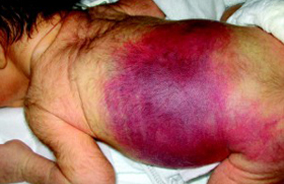Mr. Zahid Khan



The word Haemophilia derives from two Greek words: haima, meaning blood, and philia, meaning affection.
Haemophilia is a hereditary condition. This means that it is passed on from mother to child at the time of conception.
The blood of a person with Haemophilia does not clot normally. He does not bleed more profusely or more quickly than other people; however, he bleeds for a longer time.
Many people believe that Haemophiliacs bleed a lot from minor cuts. This is a myth. External wounds are usually not serious. Far more important is internal bleeding (haemorrhaging). These haemorrhages are in joints, especially knees, ankles and elbows; and into tissues and muscles. When bleeding occurs in a vital organ, especially the brain, a Haemophiliac’s life is in danger.
Haemophilia A is called by two other names:
Classical Haemophilia, because it is the most common of the factor deficiencies and
Factor VIII deficiency Haemophilia, because it is the lack of the factor 8 (written factor VIII) proteins in the blood that causes the clotting problem.
Haemophilia B also goes by two other names:
Christmas Disease, named after Steven Christmas, a Canadian who in 1952 was the first person to be diagnosed with this distinct form of Haemophilia and
Factor IX deficiency Haemophilia, because factor 9 (written factor IX) is the blood protein which is lacking and whose absence slows down the normal clotting process.
Both Haemophilia A and B are very rare disorders. Haemophilia A affects fewer than 1 in 10,000 people, or about 2500 Canadians. Haemophilia B is even less common, affecting approximately 1 in 50,000 people, or about 600 Canadians.
Factor IX deficiency Haemophilia, because factor 9 (written factor IX) is the blood protein which is lacking and whose absence slows down the normal clotting process.
However, many women who are carriers have symptoms of mild Haemophilia. We are only now fully recognizing the importance of bleeding in carriers and the degree to which these symptoms affect a woman’s quality of life.
As Haemophilia is an hereditary disorder, people are affected at birth. This means that children can have Haemophilia. In fact, Haemophilia is often diagnosed in the first year of life.
Without proper treatment, Haemophilia is crippling and often fatal. With modern treatment, most people with Haemophilia can lead full, active lives.
Haemophilia is classified as severe, moderate or mild.
Severe
Moderate
Mild
Less than 1% of normal
1 to 5% of normal
5 to 30% of normal
Severe Haemophiliacs with less than 1% of the normal level of factor VIII or IX in the blood have haemorrhages several times a month. The bleeding is often the result of a minor bump or twist. Sometimes, there is often no apparent cause for the bleeding.
Moderate Haemophiliacs bleed less often. Their haemorrhages are often the result of minor trauma, such as a sports injury.
Mild Haemophiliacs have even fewer haemorrhages. They may be aware of their bleeding problem only in the case of surgery, a tooth extraction or a serious injury. Women with mild Haemophilia may bleed more during menstruation (Periods).